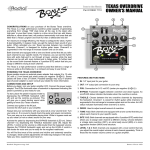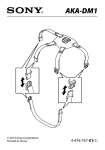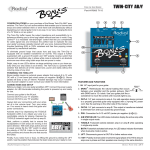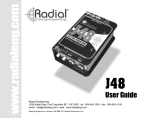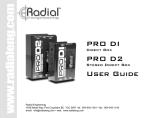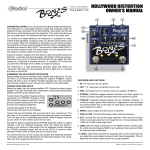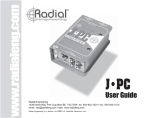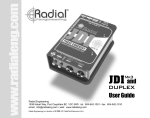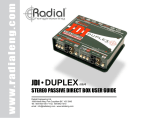Download HotShot DM-1 - Radial Engineering
Transcript
IMPORTANT NOTICE! 1 INPUT jack connects from a dynamic mic. 2 OUTPUT-1 connects to main console or 1st channel. This output is normally active. 3 OUTPUT-2 connects to sub-mixer or main console 2nd channel. This output is active only when the toggle footswitch is held down. 4 TOGGLE footswitch is momentary and routes the mic signal to output-2 when depressed. 5 LIFT switch disconnects the ground on pin-1 of output-2. 6 14 gauge steel enclosure is compact and made for heavyduty stage use. 7 Rugged glass-filled nylon XLR connectors are 100% isolated to help reduce ground loops. The DM1 is designed for dynamic microphones and is not intended for use with condenser microphones. Before you start it is important that you understand that since there are literally thousands of different sound system variables, we have no way of checking how the HotShot DM1 is used in the field. You are responsible to ensure the safe and proper use of the DM1. Using the DM1 confirms you have taken full responsibility. If you are not 100% sure of your actions, please consult a qualified technician for advice. RADIAL LIMITED THREE YEAR TRANSFERABLE WARRANTY 3 2 1 7 6 Radial Engineering - a division of JP Cabletek Electronics Ltd. warrants this product to be free from defects in material and workmanship to the original owner and will remedy any such defects free of charge according to the terms of this warranty. Radial Engineering will repair or replace at its option any defective component(s) of this product, excluding the finish, the footswitch (footswitch is warranted for 90 days) and wear and tear from normal use, for a period of three (3) years from the original date of purchase. In the event that a particular product is no longer available, Radial Engineering reserves the right to replace the product with a similar product of equal or greater value. To make a request or claim under this limited warranty, the product must be returned prepaid in the original shipping container (or equivalent) to Radial Engineering or to an authorized repair centre and you must assume the risk of loss or damage. A copy of the original invoice showing date of purchase and the dealer name must accompany any request for work to be performed under this limited warranty. This limited warranty shall not apply if the product has been damaged due to abuse, misuse, misapplication, accident or as a result of service or modification by any other than an authorized repair centre. THERE ARE NO EXPRESSED WARRANTIES OTHER THAN THOSE ON THE FACE HEREOF AND DESCRIBED ABOVE. NO WARRANTIES, WHETHER EXPRESSED OR IMPLIED, INCLUDING BUT NOT LIMITED TO, ANY IMPLIED WARRANTIES OF MERCHANTABILITY OR FITNESS FOR A PARTICULAR PURPOSE SHALL EXTEND BEYOND THE RESPECTIVE WARRANTY PERIOD DESCRIBED ABOVE OF THREE YEARS. 5 Radial Engineering 4 HotShot DM1 User Guide RADIAL ENGINEERING SHALL NOT BE RESPONSIBLE OR LIABLE FOR ANY SPECIAL, INCIDENTAL OR CONSEQUENTIAL DAMAGES OR LOSS ARISING FROM THE USE OF THIS PRODUCT. THIS WARRANTY GIVES YOU SPECIFIC LEGAL RIGHTS, AND YOU MAY ALSO HAVE OTHER RIGHTS, WHICH MAY VARY DEPENDING ON WHERE YOU LIVE. Radial Engineering HotShot DM1 User Guide www.radialeng.com FEATURE AND FUNCTIONS True to the Music HotShot DM1 Owner’s Manual Order # R800 1500 CAUTION: PLEASE READ THE IMPORTANT NOTICE ON THE BACK COVER BEFORE USING THE HOTSHOT DM1 Radial Engineering 1638 Kebet Way, Port Coquitlam BC V3C 5W9 Tel: 604-942-1001 Fax: 604-942-1010 email: [email protected] Radial Engineering is a division of C•TEC (JP CableTek Electronics Ltd.) Radial HotShot DM1 users guide Sept.. 2005, V1.0 - Part #: R870 1100 00 Subject to change without notice CONGRATULATIONS on your purchase of the Radial HotShot DM1. The Radial HotShot DM1 is a foot-controllable device that allows a vocalist to mute his or her microphone and redirect the signal to a second output to allow communication through the monitor system, in-ear wireless system or intercom. Designed specifically for dynamic microphones, the DM1 is completely passive and does not require any power. The foot selector switch is momentary, which means that the switching only occurs when the footswitch is depressed. This eliminates the need for indicator lights and batteries or external power. Typical applications include muting the FOH (front-of-house) microphone to speak to other musicians through the in-ear monitoring systems, muting the FOH to speak with technical staff or muting a mic for a cough. CONNECTING THE RADIAL HOTSHOT DM1 Before making any connections, please confirm the sound system is powered off and the volume controls are turned all the way down. Following the simple block diagram below, connect a dynamic microphone to the INPUT of the DM1. Connect OUTPUT-1 to the first channel of your mixer. Set this first mixer channel to route the signal to the main PA and monitors. Connect OUTPUT-2 to a second channel on your mixer. Set this second channel to route the signal only to the monitors. With this setup, depressing the DM1’s footswitch will effectively mute the microphone signal from the main PA mix. This allows the musician using the microphone to speak with the other musicians or technical staff through the monitors without the audience listening in. Output-1 Mixer Ch 1 PA system Output-2 Mixer Ch 2 Monitor system the gain of the two mixer channels so there is no noticeable difference in level when switching the DM1. Always begin by testing at a low volume level to make sure you do not encounter any pops or clicks when the DM1’s footswitch is depressed. If you do hear pops or clicks, check for phantom power to make sure it is off. If you hear any hum, try engaging the ground lift switch. USING THE RADIAL HOTSHOT DM1 The concept is simple: Connect the DM1 to two mixer channels. Set the first channel to route the signal to the main PA and monitors. Set the second channel to route the signal only to the monitors. Place the DM1 at the base of the microphone stand where the performer can use the footswitch. When the DM1 footswitch is not depressed, the microphone will work as it normally does and the signal will go to the main PA system and monitors. When the switch is depressed, the DM1 mutes OUTPUT-1 and redirects the signal to OUTPUT-2. The microphone will be muted in the main PA system as long as the footswitch is held down. Releasing the footswitch will revert to normal operation. Again, before you turn the volume up, begin by testing the DM1 to make sure the transition is smooth and noise-free during your sound check. USING THE DM1 WITH A SUB-MIXER If you are limited for extra channels on your mixer you can use the DM1 with a sub-mixer. This is a popular setup for bands that have each performer equipped with in-ear monitoring systems. A sub-mixer also will make it easier to interface multiple DM1s with a venue’s PA and monitor systems. Follow the same basic instructions as outlined, only this time, connect OUTPUT-2 from each DM1 to a sub-mixer which combines the signals to one channel on your main or monitor mixer. This setup allows you to consolidate all of the ‘intercom’ channels, saving valuable inputs on your mixer. Output-2 Radial Engineering Sub-mixer Main Console Ch 1 PA system Main Console Ch 2 Monitor system HotShot DM1 Footswitch Turn on your sound system. If this is the first time you’re using the DM1 we suggest testing with two mixer channels set identically so that the DM1 directs both its outputs to the same speaker system. This way, you can minimize options when troubleshooting. It is a good idea to match HotShot DM1 User Guide Why are there no light indicators on the DM1? The DM1 is designed to be a discreet switcher that allows band members to speak among themselves on stage or to technicians. A bright light going on and off during a performance can distract the audience from the performance. Can I accidentally leave the DM1 on? No. The footswitch is momentary which means that it only works when it is being depressed. This way, the only time it will mute is when you physically have your foot on the switch. This completely eliminates the need for indicator lights. Why should I be concerned about popping noise in the sound system? When PA systems are turned up, a loud transient could potentially cause a tweeter to blow. By testing the DM1 at low volume levels to make sure the DM1 does not cause any loud transients like pops or clicks, you eliminate this concern. Should I be worried about using the DM1 and the potential for pops causing system failure? No. We only underline this potential for problem so that you follow proper set-up procedures and avoid these concerns all together. The DM1 essentially works like an ON-OFF switch that is found on some microphones. Follow the setup procedures as outlined above and you should be fine. Monitor Split Output-1 At this point, your sound system should be turned off and the level controls at minimum. Make sure the 48V phantom power is turned off on the channels that you are connecting the DM1 to. Phantom power could cause loud pops in your sound system when the DM1 is switched. You are now ready to turn on your sound system and test the DM1 to make sure it works with your equipment. Can I use the DMI with a battery or phantom powered microphone? Although the DM1 may work in some cases with condenser mics, we do not recommend it due to power on/off transients which could cause the sound system to pop when switching. To be safe, only use the DM1 with dynamic mics. Can the HotShot be used in complex sound systems where there are separate FOH and monitor mixers connected with a splitter snake? Yes. The principal remains the same as when using the DM1 with a sub-mixer, only the HotShot’s OUTPUT-1 connects to the main splitter snake which passes the signal to both the FOH and monitor consoles. The following illustration outlines the basic connections for several HotShots in such a situation. HotShot DM1 Footswitch TESTING THE RADIAL HOTSHOT DM1 FAQ FOH Split DM1 Output-1 connects to main splitter snake. Sub-mixer Sub-mixer connects to monitor console. DM1 Output-2 connects to sub-mixer. Vocal 1 Vocal 2 Vocal 3 Vocal 4 USING THE DM1 AS A COUGH MUTE Monitors Wedges The DM1 can be used as a cough mute by simply not connecting OUTPUT-2. Connect OUTPUT-1 as above to the main PA system. Leave OUTPUT-2 disconnected. The microphone can now be muted whenever the footswitch is depressed. A simple solution for headset and lavalier mic users! Radial Engineering HotShot DM1 User Guide Radial Engineering HotShot DM1 User Guide





